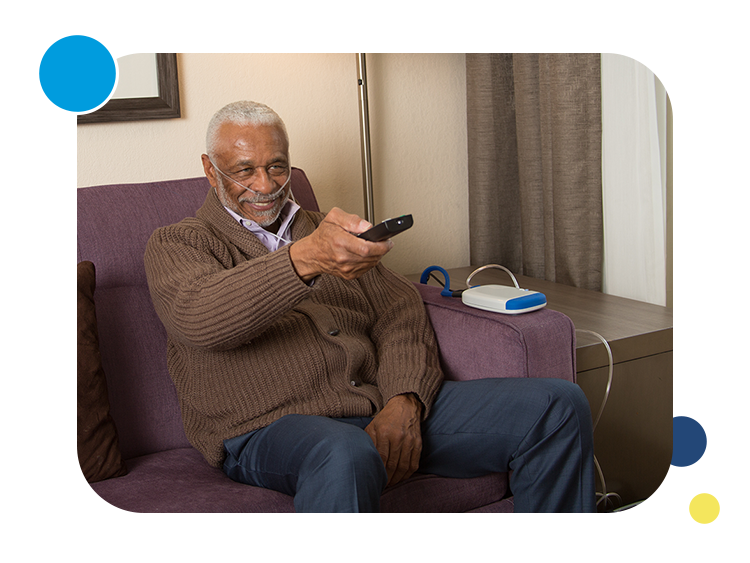Perma Pure’s Prescription Humidifier
Delivering Comfort and Safety in Respiratory Care
Problem
Perma Pure needed a compact, biocompatible humidifier for use with oxygen concentrators in both clinical and homecare settings. The challenge was to safely integrate heat, electronics, oxygen, and water into a palm-sized, user-friendly device - while meeting stringent respiratory standards and usability requirements.
This initiative was sparked by the founder’s firsthand observation of the effects of dry oxygen therapy, particularly in infants and preemies. Even short-term exposure to oxygen can dry out nasal passages, leading to bleeding, discomfort, and complications such as vomiting from swallowing blood. This issue also impacts adults with chronic conditions like COPD who rely on oxygen support.
The standard humidification method - using water bubblers - is outdated and problematic. As temperature changes, water condenses inside the oxygen tubing, creating large “slugs” of water. These can cause sudden bursts of pressure and water being shot up the nasal passage, triggering gagging and severe discomfort.
Solution
HaA Product Development led the design and development of O2asis, a prescription-grade humidifier that is durable, portable, and intuitive to use. The core innovation is a proprietary Nafion™ tubing system that passively delivers consistent micro-droplets of moisture - similar to a nebulizer - without condensation buildup. This ensures even, comfortable humidification with no risk of water slugs.
The device meets rigorous safety, usability, and biocompatibility standards while improving patient comfort in both home and clinical settings.
Outcome
A prescription-ready, user-friendly solution that eliminates the pain points of traditional oxygen humidifiers - enhancing comfort, compliance, and quality of life for oxygen-dependent patients.
Services Provided to Develop Perma Pure’s Prescription Humidifier
Research
Evaluated existing technologies (e.g., nebulizers, ultrasonic humidifiers, water bubblers).
Assessed flow rates, moisture delivery, and device configurations leveraging our medical device market research expertise.
Studied a range of oxygen machines (portable, home-based) and accessories (cannulas, tubing).
Documented optimal moisture content and functional benchmarks.
Usability
Mapped out real-world use environments: clinical (hospital wall units), in-home (large floor-standing machines), and portable travel settings.
Identified pain points such as tubing water accumulation (“slugs”) and inconsistent moisture delivery.
Developed detailed schematics and use-case scenarios to guide design decisions.
Workflow Design
Developed a complete workflow from unboxing to daily operation.
Created clear and user-centric Instructions for Use (IFU) to support intuitive setup and ongoing use.
User Feedback
Conducted in-home testing using a heuristic evaluation model.
Designed and deployed questionnaires, interviews, and prototype trials through our medical device user feedback and testing services.
Captured user feedback on schematics and functional prototypes to guide iteration.
Program Management
Estimated development costs and resource requirements.
Identified key risks and planned for component procurement, manufacturing space, and operational overhead.
Project Management
Maintained a comprehensive project schedule from concept through design freeze.
Set up full manufacturing timelines, vendor sourcing, and internal coordination checkpoints.
Regulatory Compliance
Developed a comprehensive quality agreement with the manufacturer.
Ensured biocompatibility, sterilization, labeling, and packaging adhered to regulatory standards from day one reflecting our medical device regulatory compliance services.
Industrial Design
Sketched initial concepts and built CAD models.
Down-selected designs based on human factors, environmental needs, and product workflow aligned with our medical industrial design services.
Final designs balanced form, fit, and function.
Engineering
Developed detailed product specifications.
Addressed all performance requirements: pressure ranges, flow rates, durability, drop testing supported by our medical device engineering services.
Finalized a signed-off PRD (Product Requirements Document).
CAD Development
Built a full SolidWorks 3D assembly model.
Integrated all components: subassemblies, packaging, labeling, and sterilization workflows.
Designed for manufacturability and assembly efficiency.
Prototyping
3D-printed multiple iterations for user and internal testing.
Procured electronic components, built ultrasonic welding fixtures, sourced specialized tubing.
Inspected, assembled, and evaluated all prototypes for performance and usability.
Testing
Within our testing services, we conducted:
Shock and vibration testing
Shipping durability assessments
Biocompatibility tests (per ISO 10993) on all materials in contact with skin or fluids
Ensured all safety and performance benchmarks met regulatory standards.
Additional testing: airflow efficiency, pressure drop, heat dissipation, and humidity delivery accuracy.
Site Analysis
Measured and documented floor plan of manufacturing site.
Designed optimal layout for production flow, inventory management, and assembly.
Complete Manufacturing Setup
Delivered end-to-end medical device manufacturing support to scale production efficiently
Purchased all machinery for the production line.
Procured an initial run of components.
Traveled onsite to install equipment, create work instructions, and train staff.
Built a closed-loop system for sterile water fill with required pumps for regular replenishment.



